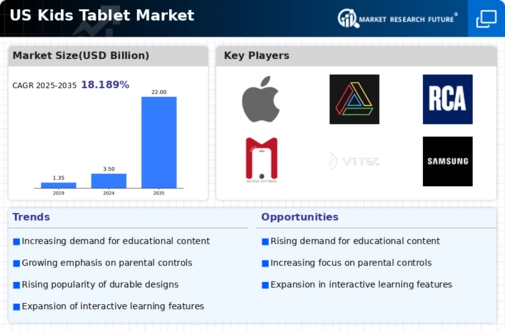The kids tablet market is currently characterized by a dynamic competitive landscape, driven by technological advancements and evolving consumer preferences. Major players such as Amazon (US), Apple (US), and Samsung (KR) are strategically positioned to leverage their brand equity and innovation capabilities. Amazon (US) focuses on integrating its ecosystem of services, enhancing user experience through content offerings tailored for children. Apple (US), on the other hand, emphasizes premium product features and parental controls, appealing to a demographic that prioritizes quality and safety. Samsung (KR) appears to be investing in educational partnerships, aiming to create a more engaging learning environment for young users. Collectively, these strategies contribute to a competitive environment that is increasingly centered around user engagement and educational value.
In terms of business tactics, companies are localizing manufacturing and optimizing supply chains to enhance responsiveness to market demands. The market structure is moderately fragmented, with several players vying for market share. This fragmentation allows for niche opportunities, particularly in educational content and specialized features tailored for children. The collective influence of key players fosters a competitive atmosphere where innovation and customer-centric approaches are paramount.
In October 2025, Amazon (US) announced the launch of a new line of educational tablets specifically designed for preschoolers, featuring interactive learning applications and parental monitoring tools. This strategic move underscores Amazon's commitment to capturing the early childhood education segment, potentially increasing its market share by appealing to parents seeking educational resources. The introduction of these tablets may also enhance customer loyalty within Amazon's ecosystem, as families are likely to engage with additional services offered by the company.
In September 2025, Apple (US) unveiled a significant update to its iPadOS, introducing features specifically designed for children, including enhanced parental controls and educational tools. This update reflects Apple's ongoing strategy to differentiate its products through superior user experience and safety features. By prioritizing child-friendly functionalities, Apple (US) aims to solidify its position in the premium segment of the kids tablet market, potentially attracting more families who value both quality and security in technology.
In August 2025, Samsung (KR) entered a partnership with a leading educational content provider to develop a series of interactive learning applications for its tablets. This collaboration is indicative of Samsung's strategy to enhance the educational value of its devices, positioning itself as a leader in the educational technology space. By integrating high-quality content with its hardware, Samsung (KR) may strengthen its competitive edge and appeal to parents looking for comprehensive learning solutions.
As of November 2025, current trends in the kids tablet market include a pronounced focus on digitalization, sustainability, and the integration of artificial intelligence. Strategic alliances are increasingly shaping the competitive landscape, as companies collaborate to enhance product offerings and expand market reach. Looking ahead, competitive differentiation is likely to evolve from traditional price-based competition to a focus on innovation, technology integration, and supply chain reliability. This shift suggests that companies will need to invest in research and development to stay ahead in a rapidly changing market.




















Leave a Comment